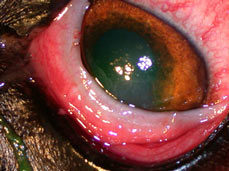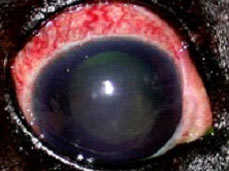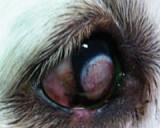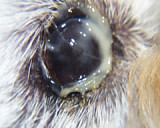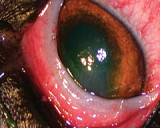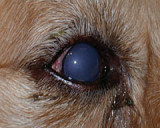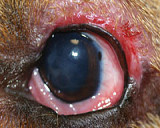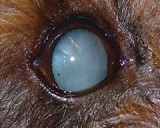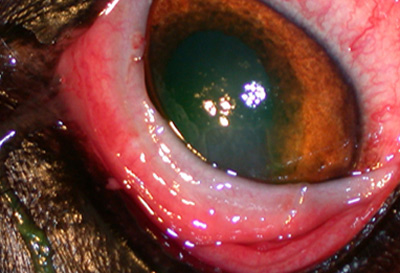 Conjunctivitis in dogs, especially long standing cases, is generally due to allergic conditions.
Conjunctivitis in dogs, especially long standing cases, is generally due to allergic conditions.
In cats most cases of conjunctivitis are due to infections from Feline Herpes Virus and Chlamydia.
In humans most cases of conjunctivitis are due to infections that will readily respond to antibiotics.
Clinical Signs
Clinical Signs of Conjunctivitis:
1. Ocular discharge - this can vary from watery to mucky discharge
2. Redness/Inflammation
3. Ocular irritation - the patient may rub at the eye
Diagnosis
Diagnosis
A diagnosis can be made on clinical signs. Other diagnostic tests that may be considered include conjunctival cytology. In rare cases bacterial culture and biopsy may be required. In cats a swab may be taken for PCR testing for Feline Herpes Virus and Chlamydia.
Management
Management in Dogs
* Wipe the eyes clear of any mucky discharge
* If the dog has other signs of allergy such as eczema, dermatitis or ear problems, it may be worthwhile doing allergy testing. This is generally done in conjunction with your local veterinarian.
* Most dogs with chronic conjunctivitis will require long term treatment. Unlike in humans, long-term cortisone drops will not cause cataracts or glaucoma. The only potential complication is if something else happens to the eye, the cortisone drops can make an ulcer or an infection worse. So stop the drops if the eye is suddenly more closed, watery, mucky, blue or red.
CONJUNCTIVITIS
* Most chronic cases of conjunctivitis in dogs can only be controlled rather than cured.
Management in Cats
* Most cases of conjunctivitis in cats are secondary to infections such as Feline Herpes Virus or Chlamydia. It is important to keep the eyes as clean as possible of any discharge. Chlamydia can in rare cases infect humans so it is important to wash your hands after cleaning the cat’s eyes.
* Cats with conjunctivitis will generally require a 3 week course of antibiotic tablets. We have found that double the recommended dose is required at twice daily to eradicate Chlamydia. Other cats can act as carriers, so it is important to treat all cats in the household.
* Most feline conjunctivitis cases settle well after the prolonged antibiotic course. In some cases it may be necessary to use anti-inflammatory medications to resolve an underlying reaction. Cats can occasionally get unusual reactions such as eosinophilic keratoconjunctivitis. These can be difficult to treat.
Potential Complications from Conjunctivitis Dry Eye (keratoconjunctivitis sicca): This is a deficiency of the tears which normally bathe the cornea and conjunctiva. Dry eye can either cause or can be the result of conjunctivitis. It is important to regularly check the tear readings in both eyes. Thick mucky discharge with a dry look to the eyes is characteristic of dry eye. The normal tear reading for a dog is >15mm, for a cat >10mm wetting in a minute.
Entropion: This is where the eyelid rolls onto the eyeball. It is seen most commonly in large breed dogs such as Rottweilers. In most cases eyelid surgery is required even if the primary conjunctivitis is treated.
Corneal scarring: In some severe cases of conjunctivitis, the inflammation can spread onto the cornea causing reaction in the cornea - keratitis. In most cases the conjunctivitis treatment will reduce the corneal reaction.
